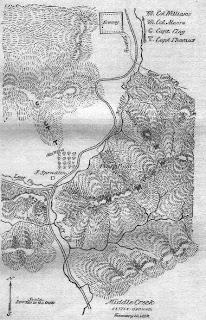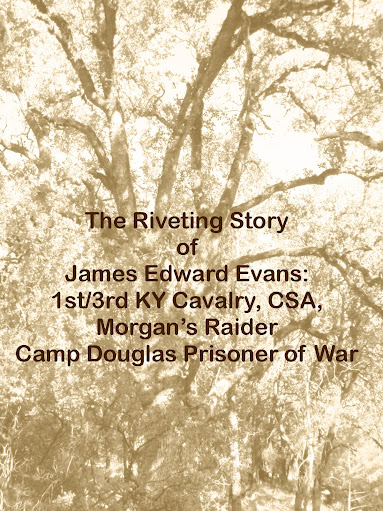
General Marshall's Battle Map of Middle Creek
With both Union and Confederate troops occupying the Commonwealth, it was inevitable that battles and skirmishes would occur.
Kentucky lived up to its fabled reputation as “Dark and Bloody Ground.”
November 8, 1861
Floyd County in Eastern Kentucky saw the Battle of Ivy Mountain.
“While recruiting in southeast Kentucky, Rebels under Col. John S. Williams ran short of ammunition at Prestonsburg and fell back to Pikeville to replenish their supply. Brig. Gen. William Nelson sent out a detachment from near Louisa under Col. Joshua Sill while he started out from Prestonsburg with a larger force in an attempt to “turn or cut the Rebels off.” Williams prepared for evacuation, hoping for time to reach Virginia, and sent out a cavalry force to meet Nelson about eight miles from Pikeville. The Rebel cavalry escaped, and Nelson continued on his way. Williams then met Nelson at a point northeast of Pikeville between Ivy Mountain and Ivy Creek. Waiting by a narrow bend in the road, the Rebels surprised the Yankees by firing upon their constricted ranks. A fight ensued, but neither side gained the bulge. As the shooting ebbed, Williams’s men felled trees across the road and burned bridges to slow Nelson’s pursuing force. Night approached and rain began which, along with the obstructions, convinced Nelson’s men to go into camp. In the meantime, Williams retreated into Virginia, stopping in Abingdon on the 9th. Sill’s force arrived too late to be of use, but he did skirmish with the remnants of Williams’s retreating force before he occupied Pikeville on the 9th. This bedraggled Confederate force retreated back into Virginia for succor. The Union forces consolidated their power in eastern Kentucky mountains.”[i]
The moving tale of Private William Barker, who was killed during the battle, can be found at http://www.geocities.com/Heartland/9999/PrivateWilliamBarker.html
November 18, 1861
During a Sovereignty Convention in Russellville, Confederate leadership established the Provisional Government of Kentucky. George W. Johnson was elected the governor and Bowling Green, Kentucky was selected as the capital of “Confederate Kentucky.”
Confederate General Albert Sidney Johnston’s army was encamped at Bowling Green as protection for Governor Johnson's provisional government.
The Provisional Government was never able to replace the elected government in Frankfort, headed by Governor Beriah Magoffin. Magoffin refused to recognize Confederate attempt to establish a government within the Commonwealth. Much of the citizenry followed their Governor’s example.
December 10, 1861
Heedless to realities within the Commonwealth, the Confederate Congress in Richmond, Virginia recognized the Provisional Government and admitted Kentucky into the Confederate States of America. Kentucky was represented by the central star on the Confederate battle flag.
As the official elected Kentucky General Assembly had strong Union ties, Kentucky never succeeded from the Union. Kentucky offically remained a state of the Union.
Thus Kentucky became a Belle claimed by rival suitors and was doomed to have her heart destroyed.
December 28, 1861
The largest cavalry battle to take place in Kentucky during the Civil War was the Battle of Sacramento. Fought between the forces of Confederate Colonel Nathan Bedford Forrest and Union Brigadier General Thomas L. Crittenden, this battle is sometimes referred to as “Forrest’s First Fight.”
Crittenden was charged with holding a line along the Green River. Forrest’s task was to break it. The fight, which began south of Sacramento, became a running battle through the town and continued for another two miles. In achieving victory, Forrest proved the strength and value of the Confederate cavalry.
Meanwhile, Northern banks in New York, Boston, and Philadelphia were facing a shortage of gold. Republican Congressman Elbridge C. Spaulding of New York, a member of the House Ways and Means Committee, proposed a solution. He drafted a bill suggesting that paper money, payable on demand by the U.S. Treasury but unbacked by gold or silver, be made the legal tender for all debts. The constitutionality of this idea was questionable, but Attorney General Edward Bates upheld its legality. His ruling sparked heated congressional debates.[ii]
Across the pond, neutral Englishmen were not above chiming in on the causes of the war:
"So the case stands, and under all the passion of the parties and the cries of battle lie the two chief moving causes of the struggle. Union means so many millions a year lost to the South; secession means the loss of the same millions to the North. The love of money is the root of this, as of many other evils. The quarrel between the North and South is, as it stands, solely a fiscal quarrel."
~ Charles Dickens, December 28, 1861[iii]
January 10, 1862
Kentuckian slew Kentuckian in hand-to-hand combat as the Battle of Middle Creek raged between forces under Union Colonel James A. Garfield and Confederate General Humphrey Marshall.
While a relatively same battle by Civil War standards, the battle was none the less poignant as the Confederate 5th Kentucky Infantry and Union 14th Kentucky Infantry faced each other in a literal “neighbor versus neighbor” battle.
With this decisive battle, Union forces halted the Confederate offensive in eastern Kentucky. The strategic advantage lost by the Confederates was never to be regained. The Confederates had lost control of Kentucky.
The results of the battle forever changed the lives of the two commanders. Former Ohio State Senator James Garfield gained national recognition after victory at Middle Creek. Returning to his political career at the war’s end, Garfield eventually became the 20th United States President. Humphrey Marshall a native of Kentuckywho had found fame as a hero of the Mexican War, had served as a four term U. S. Senator prior to the Civil War. Now blamed for defeat, Marshall spent the remainder of his military career under a shadow of doubt as Confederate authorities openly questioned his ability to lead.
January 19, 1862
The Battle of Mill Springs was fought in Pulaski County, Kentucky under Union General George H. Thomas and Confederate General George B. Crittenden.
During a nasty rain storm, Thomas launched an advance on Crittenden’s postion. Due to the heavy rains, the advance was so slow that Crittenden men were able to intercept them. It looked as if the Confederates would have an easy victory.
Yet, in the rain and darkness, Felix Zollicoffer,commander of Crittenden’s First Brigade, became disoriented. In an attempt to prevent tragedy, Lt. H. M. R. Fogg, charged in calling out to Zollicoffer. Alert Union soldiers took aim. Both Fogg and Zollicoffer were killed.
Union forces arrived from Somerset to reinforce Thomas and the Confederates were forced to retreat across the Cumberland River.
"I have been in the U.S. service for 4 months and have been marching ever since and was in the battle of Mills Springs and hoped to whip that old devil Zolly Coffer. I saw him when he fell in the field of battle. George, I tell you there was no fun in fighting. To hear the balls whistling over your head and cutting your clothes off and seeing men fall like hay before a scythe, it will scare a fellow a little. Battle is no chance for dodging. All we have to do is put our trust in God and keep our powder dry."
~ Private John H. Burch
“The battle of Mill Springs, along with one at Middle Creek broke whatever Confederate strength there was in eastern Kentucky.”[iv]
February, 1862
Confederate General Johnston retreated from Bowling Green moving his army southward into Tennessee.
Provisional Governor Johnson and his council, finding their government unprotected, were forced to flee into Tennessee. The Provisional Government was forced to set up its headquarters in army tents and travel with Kentucky Units of the Confederate Army.
“I am determined to share the dangers of the battle with these boys.”
~Governor George W. Johnson
During the battle at Shiloh, Governor Johnson insisted he be sworn in as a private. He flatly refused to stand idly by as Confederate boys fell. Taking up position despite his crippled arm, he fought along side the boys of Company E, 4th Kentucky Infantry until he was wounded in the right thigh and lower abdomen. Governor Johnson died aboard the Union hospital shipl Hannibal after having been mortally injured at Shiloh.
Most of Kentucky was now under Union military and political control but all was not going well in the North.
Abraham Lincoln, unable to stem the gold crisis, signed the Legal Tender Act into law. "Greenbacks" began to circulate early in April.[v]
ENDNOTES
[i] CWSAC Battle Summaries: Ivy Mountain http://www.nps.gov/hps/abpp/battles/ky003.htm
[ii] Faust, Patricia L "Historical Times Encyclopedia of the Civil War."
[iii] Dickens, Charles. "All The Year Round."
[iv] Bush, Bryan S. “The Civil War Battles of the Western Theatre ” 1998, p. 20.
[v] Faust, Patricia L. "Historical Times Encyclopedia of the Civil War."





No comments:
Post a Comment